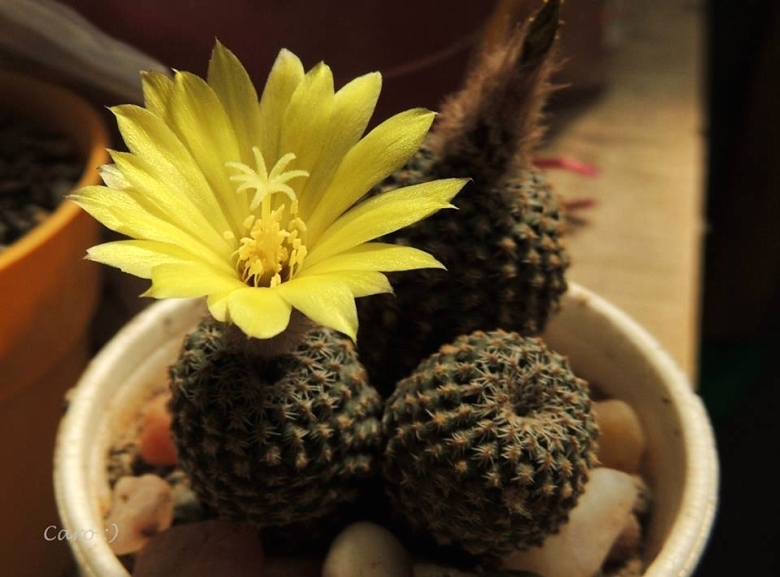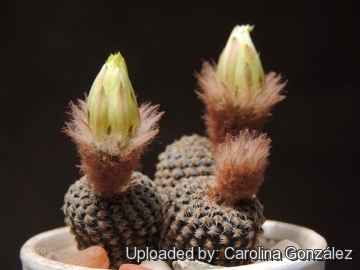Accepted Scientific Name: Frailea buenekeri W.R.Abraham
Succulenta (Netherlands) 69(3): 64 (1990)

Astrophytum buenekeri (Frailea buenekeri) Photo by: Carolina González
Origin and Habitat: Frailea buenekeriSN|3534]]SN|3534]] is endemic to Rio Grande do Sul, Brazil, it has a small range, with an extent of occurrence of less than 5,000 km2.
Altitude range: This species occurs at an altitude of 200 metres above sea level.
Habitat and Ecology: This species grows on rocky outcrops and stony fields in pampa grasslands. Its habitat has a very high potential to be used for agriculture. The species is not abundant and is naturally severely fragmented. The population is declining. The major threats to this cactus are grazing (cattle trampling), agriculture, forestry of Eucalyptus for paper industry, invasive African grasses and fire. Human-induced fires used to be more frequent in the past, and even though they are decreasing in frequency they still are a threat to the species.
Synonyms:
See all synonyms of Frailea buenekeri
Description: Frailea buenekeriSN|3534]]SN|3534]] is one of the smallest of the globular species that does not exceed 2 cm in height or diameter. Two subspecies are recognized, the nominate form and subsp. densispina Hofacker & Herm.
Habit: It is a s small perennial stem succulent, usually solitary, rarely offsetting or many-stemmed forming low, flat clusters that grow deeply seated flat to the ground surface. Only in cultivation plants may have a spherical till columnar shape.
Derivation of specific name: Frailea buenekeriSN|3534]]SN|3534]] was named in honour of Heinrich Büneker (1900-1971), collector of the type.
Stem: Depressed globose, reddish brown with the epidermis finely dotted, 1.5-2 cm tall, 1.5-2 cm in diameter.
Roots: Strongly tuberous, more or less conical, with fine lateral diffuse roots.
Ribs 14-19: Low, and tuberculate with dark purple “moons” under their areoles .
Areoles: Oval, to 1 mm long.
Spines: 8-11, white, pectinate, 1-2 mm long.
Flowers: Sulphur yellow, sometimes with reddish midveins, 2.5-4 cm long, 2.5-6 cm in diameter.
Fruits: Reddish brown, 1-2 cm long, 7-13 mm in diameter.
Subspecies, varieties, forms and cultivars of plants belonging to the Frailea buenekeri group
 Frailea buenekeri W.R.Abraham: has stems less than 2 cm in height or diameter, 14-19 ribs and 8-11 spines. Flowers and fruits comparatively smaller. Distribution: West of Sao Gabriel near the town of Vila Nova do Sul.
Frailea buenekeri W.R.Abraham: has stems less than 2 cm in height or diameter, 14-19 ribs and 8-11 spines. Flowers and fruits comparatively smaller. Distribution: West of Sao Gabriel near the town of Vila Nova do Sul.- Frailea buenekeri subs. centrispina n.n.: has a more dense cover of pure white spines, and a single white to yellowish-brown central spine, which is stronger than the radial. Distribution: east of the areal near the town of Santana da Boa Vista.
 Frailea buenekeri subs. densispina Hofacker & K.Herm: has stems up to 6 cm tall and 4 cm in diameter, 19-23 ribs, and 10-14 spines. Flowers and fruits are much larger. Distribution: south and southwest of Sao Gabriel west of the town of Lavras do Sul and east of the small village of Ibaré.
Frailea buenekeri subs. densispina Hofacker & K.Herm: has stems up to 6 cm tall and 4 cm in diameter, 19-23 ribs, and 10-14 spines. Flowers and fruits are much larger. Distribution: south and southwest of Sao Gabriel west of the town of Lavras do Sul and east of the small village of Ibaré.
Notes: Some of the most sought-after Fraileas are those with dark purple “moons” under their areoles. Frailea cataphractaSN|21482]]SN|3597]] is the most typical example, but remarkable dark “moons” are also found in several other species like: Frailea mammiferaSN|3534]]SN|3646]], Frailea klinglerianaSN|25385]]SN|25385]], Frailea buenekeriSN|3646]]SN|3534]] and Frailea schlosseriSN|3597]]SN|21482]]
Bibliography: Major references and further lectures
1) Edward Anderson “The Cactus family” Timber Press, Incorporated, 2001
2) David R Hunt; Nigel P Taylor; Graham Charles; International Cactaceae Systematics Group. "The New Cactus Lexicon" dh books, 2006
3) Larocca, J., Machado, M. & Duarte, W. 2013. Frailea buenekeri. The IUCN Red List of Threatened Species. Version 2014.3. <www.iucnredlist.org>. Downloaded on 07 May 2015.
4) Marlon C Machado “Fascinating Frailea, Part 2: Review of the species from Rio Grande do Sul” Cactus World (BCSS) Volume 25 No. 2 June 2007
 Astrophytum buenekeri (Frailea buenekeri) Photo by: Carolina González
Astrophytum buenekeri (Frailea buenekeri) Photo by: Carolina González Astrophytum buenekeri (Frailea buenekeri) Photo by: Carolina González
Astrophytum buenekeri (Frailea buenekeri) Photo by: Carolina GonzálezCultivation and Propagation: Fraileas are are tiny plants with comparatively big yellow flowers, often bigger than the whole plant itself and are especially suitable for those with limited growing space. They can be easily grown in a sunny windowsill or a small greenhouse. The secret for keeping Fraileas happy and growing is to pot them in a rich, porous soil with good drainage and aeration, to give them lots of water and let them dry out between waterings. Fraileas do like more water than most other cacti. If you over-pot them (in about 6-7 cm pots) they grow much better and healthier, as they can be quite short-lived if not given correct growing conditions. During winter they like cool and dry places (minimum temperature of 5-10° C) but even light frosts do not harms them. Characteristically, during the dry season plants retract completely under the ground, both in the wild and in cultivation too. Occasional light spray of water during the winter helps plants from shrivelling up too much. In the summer they like the pot to be filled with rainwater (which is always better to use than tap water) quickly absorbed by the plants, and one can almost see the little bodies swelling up. After a day or two, it is best to drain off any remaining water in the under-pots.
Sun Exposure: They enjoy full sun. In a shaded position the plants grow faster, but are not flat shaped or dark coloured.
Propagation: With fresh harvested seeds or (rarely) by grafting. The seeds germinates well. Sow the them on the soil surface, so that they can grow to a reasonable size before they have to be pricked out into a bigger tray. The seed trays go into a heated propagator on a windowsill where they catch the afternoon sun. It does not take long for the seeds to germinate, and some will do so within a day or two after sowing. When they have reached a height of about 1 cm they are pricked out into a larger tray, where they remain until they are large enough to go into individual pots.













